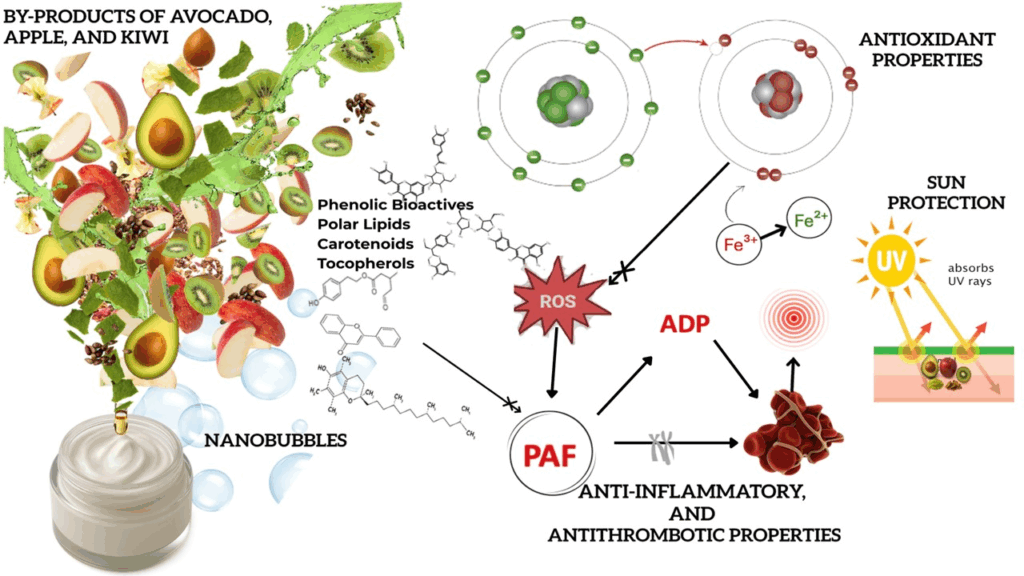The pursuit of sustainable development necessitates a crucial shift toward a circular economy model, particularly in industries dealing with significant agri-food waste. By-products from commonly consumed fruits, such as avocado, apple, and kiwi, are frequently discarded despite being rich sources of organic bioactives, specifically phenolic compounds. This waste contributes to environmental issues, but their valorization offers a dual benefit: environmental protection and the development of innovative, health-promoting products.
A major concern in modern skincare is photoaging, driven by oxidative stress and chronic inflammation resulting from exposure to ultraviolet (UV) radiation. This stress can lead to premature skin aging and, in chronic cases, skin tumors and melanoma, which involve inflammatory mediators like Platelet-Activating Factor (PAF). Therefore, there is a strong demand for cosmetic formulations enriched with natural substances possessing multifunctional properties—antioxidant, anti-inflammatory, and antiplatelet—to provide enhanced protection and revitalization. The solution considered was to integrate extracts derived from sustainable fruit by-products into anti-UV creams. Furthermore, to overcome the critical challenge of ensuring these active compounds effectively penetrate the deeper skin layers, the study investigated incorporating nanobubbles (NBs), small gas cavities known for their stability and large surface area, as a promising green technology for transdermal delivery. The central aim was to develop anti-photoaging cosmetic formulations leveraging these extracts, with NBs hypothesized to facilitate deeper absorption and optimize efficacy.
Methods
The study developed three cosmetic cream formulations: a control (X), one with a synergistic blend of avocado, apple, and kiwi by-product extracts (S), and one with extracts formulated using nanobubble-enriched water (NB). Antioxidant capacity was evaluated using DPPH and FRAP assays, while photoprotective capacity was determined by calculating the Sun Protection Factor (SPF) using UV-Vis spectroscopy and the Mansur equation. Transdermal absorption was simulated and assessed via Attenuated Total Reflectance Fourier-transform infrared spectroscopy (ATR-FTIR) utilizing Strat-M® synthetic membranes. Biological activities were tested by evaluating the inhibitory effects (IC50) of the creams against Platelet-Activating Factor (PAF) and Adenosine Diphosphate (ADP)-induced platelet aggregation in human platelet-rich plasma (hPRP). Finally, molecular docking analysis was conducted on representative phytochemicals (Phloretin, Rutin, and Quercetin) against the human Platelet-Activating Factor Receptor (PAFR) to provide molecular insight into the anti-inflammatory results.
Key Findings
• Enhanced Antioxidant Capacity (FRAP): Extract-containing creams (S and NB) exhibited significantly higher antioxidant capacity, achieving up to a 250% improvement in the FRAP assay compared to the base cream (X), and demonstrated stable antioxidant activity during one month of storage.
• SPF Preservation: While the SPF of the base cream (X) decreased after storage, the SPF of the extract-containing cream (S) increased (from 8.7 ± 0.8 to 9.5 ± 0.6), suggesting that the natural bioactives helped maintain or enhance photoprotective capacity over time.
• Strong Antiplatelet/Anti-inflammatory Activity: Extracts significantly enhanced anti-inflammatory and antiplatelet properties, evidenced by markedly lower half maximal inhibitory concentration (IC50) values compared to the control cream (X) for both the PAF pathway (e.g., S: 300.0 ± 42.0 µg/mL vs. X: 685.0 ± 35.0 µg/mL at production) and the ADP pathway. This enhanced bioactivity was retained after 30 days of storage, unlike the control.
• Improved Penetration: ATR-FTIR analysis using Strat-M® membranes revealed enhanced penetration and absorption of active compounds in the enriched creams compared to the control, suggesting that components from the extracts reach deeper layers of the simulated epidermis.
• Molecular Docking Validation: In silico analysis provided molecular support for the anti-inflammatory findings, showing strong thermodynamic binding affinity between selected phytochemicals and the PAFR. Quercetin demonstrated the most optimal docking score (−9.0 kcal/mol), followed closely by Phloretin (−8.8 kcal/mol), suggesting they act as strong orthosteric inhibitors competing with PAF.
• Nanobubble Effect: NBs did not significantly enhance immediate antioxidant, SPF, or antiplatelet performance in the in vitro assays compared to extracts alone. However, FTIR analysis indicated that NB-assisted formulations showed improved retention and absorption of bioactive compounds, suggesting a potential role in delivery enhancement that warrants optimization.
Regarding future implications, while the nanobubbles (NBs) showed modest effects on immediate in vitro endpoints, they enhanced the absorption and retention of active compounds. This suggests that NB technology requires further optimization, possibly by exploring different NB gases (e.g., CO2 or N2) and improved process parameters to maximize NB stability and delivery efficiency for enhanced in vivo benefits. Overall, the study highlights a promising, eco-friendly strategy for developing stable and effective cosmetic products. Future research must prioritize extended stability assessments and well-designed clinical trials to confirm the observed efficacy, ensure long-term safety, and validate the potential of these sustainable formulations for commercial skin-health-promoting applications.
Link to the study: https://www.mdpi.com/2079-9284/12/5/231


